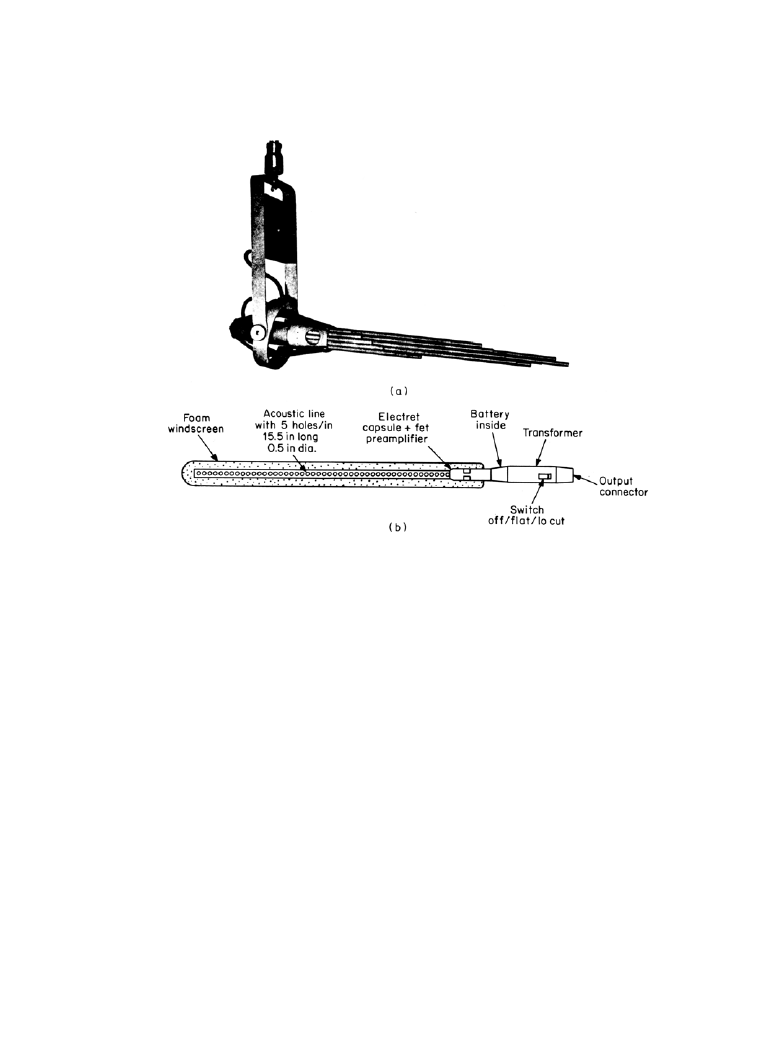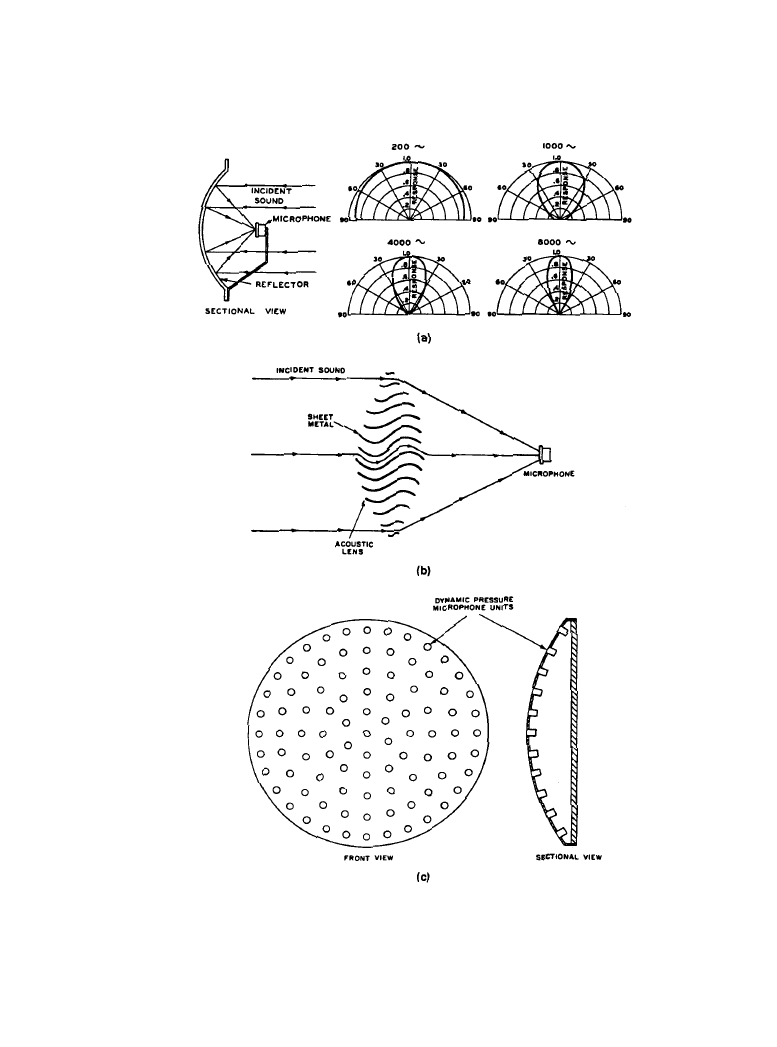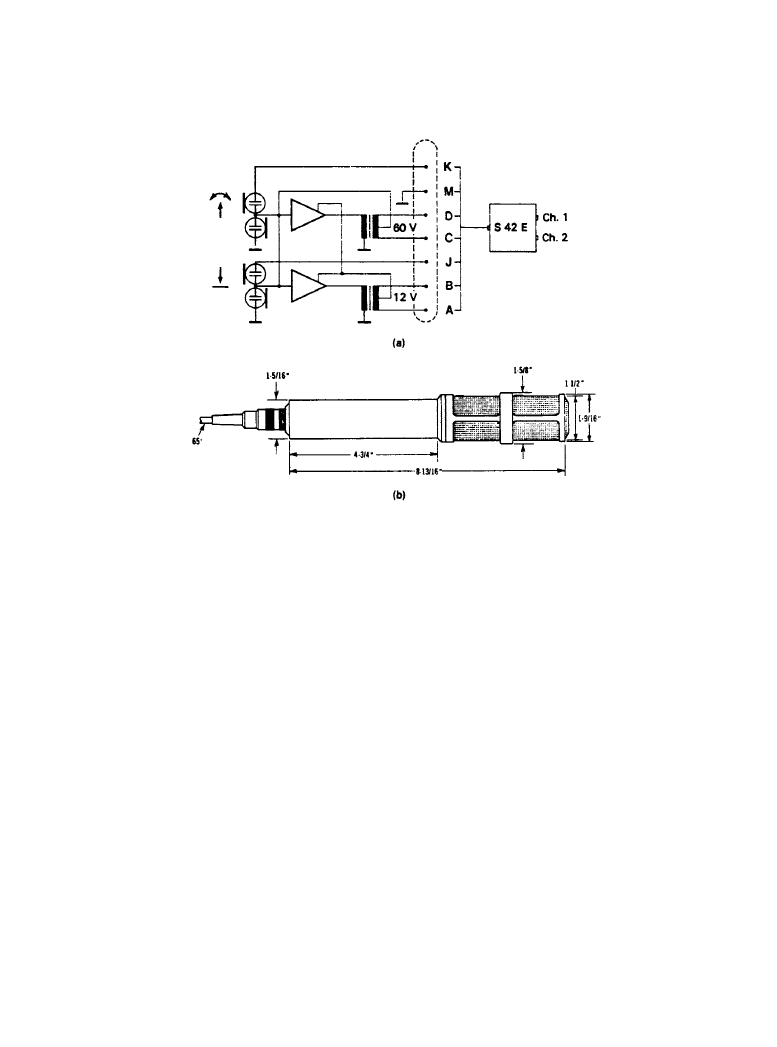ВУЗ: Казахская Национальная Академия Искусств им. Т. Жургенова
Категория: Книга
Дисциплина: Не указана
Добавлен: 03.02.2019
Просмотров: 21639
Скачиваний: 19

4-30 Microphone Devices and Systems
Where:
f
c
= frequency, Hz
c = velocity of sound = 331 m/s
L = total length of line
The high-frequency limit of the ultradirectional region is determined by the hole spacing dS
(4.1.12)
where dS is the hole spacing, m.
If f
c
is chosen to be 100 Hz, then L must equal 65 in (1.66 m), which is too long for most prac-
tical applications. However, this requirement may be eased by substituting a pressure-gradient
cardioid element. This provides good 180° rejection below f
c
, and with careful optimization of
parameters a microphone of practical length can have good rejection at 90°, well below f
c
. It is
relatively easy to achieve f
n
= 10,000 Hz or higher with practical hole spacings.
Alternately, the line may consist of a bundle of small tubes of lengths which vary from dS to L
in even steps of dS. Similarly, a single pipe with a series of slots may be used. With modern
small-diaphragm condenser transducers, the single pipe is appropriate because the diameters of
f
n
C
2dS
---------
=
Figure 4.1.22
Line microphones: (
a) bundled pipes, (b) single pipe with holes and electret con-
denser.
Downloaded from Digital Engineering Library @ McGraw-Hill (www.digitalengineeringlibrary.com)
Copyright © 2004 The McGraw-Hill Companies. All rights reserved.
Any use is subject to the Terms of Use as given at the website.
Microphones

Microphones 4-31
the tubes in a bundle would be so small that the acoustic resistance (viscosity) loss would reduce
sensitivity and roll off the high-frequency response.
Figure 4.1.22 shows an electret condenser line microphone with a small-diameter line and a
transducer capsule 0.6 in (16 mm) in diameter. The capsule and line are made as an assembly that
is interchangeable with standard cardioid and pressure elements. Although f
c
is 420 Hz, 15-dB
rejection is maintained at 90° down to 100 Hz [15].
4.1.4b
Wave Microphones
A parabolic reflector may be used to concentrate distant parallel rays of sound at a microphone
placed at the focus. This concept is illustrated in Figure 4.1.23a. As in all wave-type micro-
phones, the reflector must be large compared with a wavelength of sound to obtain a high order
of directivity.
An acoustic lens microphone is a lens-like device made of sheet metal that can focus sound
waves onto a microphone in a manner similar to the parabolic reflector (Figure 4.1.23b). The
directivity follows the laws of wave-type microphones in much the same way as the parabola [2].
A large-surface microphone consisting of a large number of pressure-microphone elements
arranged on a spherical surface is shown in Figure 4.1.23c. The polar pattern is similar to that of
a curved-surface sound source, which emits uniformly over a solid angle subtended by the sur-
face at the center of curvature. The microphone shown in Figure 4.1.23c is 4 ft (1.22 m) in diam-
eter and has an angular spread of 50°. The pattern is reasonably uniform above 300 Hz [2].
4.1.5
Miscellaneous Types of Microphones
A two-channel microphone such as the one shown in Figure 4.1.24 is a convenient tool for sound
pickup in the x-y or M-S stereophonic modes where coincident microphone transducers are
required. The example device shown utilizes two dual-diaphragm condenser transducers, which
are mounted on top of each other and in adjacent capsules sharing a common axis; the capsules
may be rotated with respect to each other. A remote-control unit permits any one of nine polar
patterns to be selected for each channel.
4.1.5a
Sound-Field Microphone
The original sound-field microphone was developed for the ambisonic surround system patented
by the United Kingdom National Research Corporation and was produced by Calrec Audio Lim-
ited. This system was a form of quadraphonic sound. A later version of the device became essen-
tially an electronically steerable stereophonic microphone. Four single-diaphragm cardioid
condenser capsules are mounted in a tetrahedral array and connected to an electronic control
unit. This unit permits selection of cardioid, figure-of-eight, and omnidirectional patterns for
each stereo output. In addition, the sound pickup axes may be electronically steered in azimuth
and elevation. By processing the pressure and pressure-gradient components of the audio signal,
the microphone may be moved fore and aft as the ratio of direct to reverberant sound is varied.
The electronic steering may be done before or after the audio is recorded, allowing flexibility in
the postproduction phase of sound recording.
Downloaded from Digital Engineering Library @ McGraw-Hill (www.digitalengineeringlibrary.com)
Copyright © 2004 The McGraw-Hill Companies. All rights reserved.
Any use is subject to the Terms of Use as given at the website.
Microphones

4-32 Microphone Devices and Systems
Figure 4.1.23
Wave microphones: (
a) parabolic reflector, (b) lens, (c) large-surface. (From [3].
Used with permission.
Downloaded from Digital Engineering Library @ McGraw-Hill (www.digitalengineeringlibrary.com)
Copyright © 2004 The McGraw-Hill Companies. All rights reserved.
Any use is subject to the Terms of Use as given at the website.
Microphones

Microphones 4-33
4.1.5b
Lavaliere Microphone
The term lavaliere microphone refers to a small microphone that is typically fastened to the
clothing of the speaker. When resting on the chest, the microphone requires rising high-fre-
quency response compensation to adjust for the loss in response due to its location off the axis of
the mouth. Very small electret condenser models available today utilize a subminiature pickup
element. They are light enough so that they may be fastened to the clothing by means of a small
clip attached to the cable below the microphone.
4.1.5c
Wireless Microphone
A variety of wireless microphones are available today, usually either in a hand-held style or as a
lavaliere microphone connected to a separate body-pack transmitter. These systems are widely
used in television broadcasting and in professional entertainment.
4.1.6
Selecting Microphone Types
The hand-held microphone, probably the most popular type of mic, is available in many shapes
and sizes. Manufactured in both directional and non-directional versions, the hand-held mic pro-
vides wide frequency response, low handling-noise and a wide choice of characteristic “sounds.”
Figure 4.1.24
Stereophonic condenser microphone: (
a) wiring diagram, (b) shell construction.
Downloaded from Digital Engineering Library @ McGraw-Hill (www.digitalengineeringlibrary.com)
Copyright © 2004 The McGraw-Hill Companies. All rights reserved.
Any use is subject to the Terms of Use as given at the website.
Microphones

4-34 Microphone Devices and Systems
Because adequate space is available, a shock-mount system is incorporated into most profes-
sional hand-held microphones. Just holding a microphone or dragging the cable across a floor
can cause low-frequency noise to be transmitted to the pickup element. A shock-mount system
minimizes such noise.
The lavaliere microphone is also in high demand today. Its small size and wide frequency
response offer professional users what appears to be the best of all worlds. Small size translates
into minimum visual distraction on camera or before an audience. Wide frequency response
assures good audio quality. There are other points to consider, however, before a lavaliere micro-
phone is chosen for a particular application.
The smallest lavalieres available are omnidirectional. This makes the talent’s job easier
because staying on mic is less of a problem. However, extraneous noise from the surrounding
area can result in a generally poor pickup. The omnidirectional lavaliere microphone can pick up
unwanted sounds just as easily as it captures the talent’s voice. In an indoor, controlled environ-
ment, this is usually not a problem. However, outside the ambient noise can make the audio track
unusable.
Directional lavalieres are available, but they too have performance tradeoffs. The most obvi-
ous is size. In order to make a lavaliere directional, a back entry usually must be added to the
housing so that sound can reach the back of the microphone. This translates into a larger housing
for the microphone capsule. Although not as large as a hand-held microphone, a unidirectional
lavaliere is noticeably larger than its omnidirectional counterpart.
In order to keep the size under control, shock-mounting of the directional capsule is usually
kept to a minimum. This results in a microphone that exhibit more handling noise than a compa-
rable omni.
Windscreens for lavaliere microphones are a must on any outdoor shoot. Even a soft breeze
can cause the audio track to sound as if it was recorded in a wind tunnel. The culprit is turbu-
lence, caused by wind hitting the grille or case of the microphone. The sharper the edges, the
greater the turbulence. A good windscreen helps to break up the flow of air around the micro-
phone and reduce turbulence.
Windscreens work best when fitted loosely around the grille of the microphone. A wind-
screen that has been jammed down on a mic only serves to close off part of the normal acoustic
path from the sound source to the diaphragm. The end result is attenuated high-frequency
response and reduced wind protection.
4.1.7
References
1.
Olson, H. F. (ed.): McGraw-Hill Encyclopedia of Science and Technology, 5th ed., vol. 18,
McGraw-Hill, New York, N.Y., pg. 506, 1982.
2.
Olson, H. F.: Acoustical Engineering, Van Nostrand, Princeton, N.J., 1957.
3.
Rasmussen, G.: “A New Condenser Microphone,” Tech. Rev., Bruel & Kjaer, Copenhagen,
no.1, 1959.
4.
Olson, H. F.: “Directional Electrostatic Microphone,” U.S. Patent 3,007,012, October 31,
1961.
Downloaded from Digital Engineering Library @ McGraw-Hill (www.digitalengineeringlibrary.com)
Copyright © 2004 The McGraw-Hill Companies. All rights reserved.
Any use is subject to the Terms of Use as given at the website.
Microphones